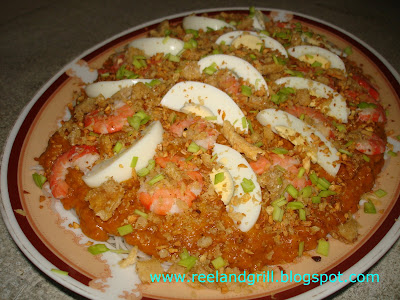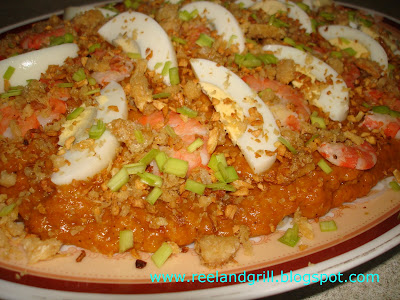_timestamp.JPG)
Cravings for “Pansit Palabok” suddenly strike us and due to unrelenting request from friends I decided to haphazardly prepare one. I have most of the ingredients including “chicharon” (pork skin cracklings) from the Philippines, pork head meat, shrimps and thin rice noodles. Though I don’t have “tinapa” (smoked fish) which they don’t sell here in Sri Lanka, I believe what I have in hand would suffice to create a modest “palabok” dish that could somehow ease the cravings.
“Pansit Palabok” also called “Pansit Luglug” is a savoury noodle dish very popular in Tarlac and Pampanga (Philippines). I believe the original name is “pansit luglug”, “luglug” being the “Capampangan” word for the method of cooking the thin noodles of soaking in boiling water for several minutes until al dente then placed in a platter and topped with the sauce and the various toppings. I heard that in Pampanga, it is originally eaten with thin slices of “kamias” (cucumber tree) instead of the now widely used calamansi juice. When “pansit luglug” clashed with the Tagalog version called “pansit palabok” which is quite similar but using thicker noodles, the two names became synonymous in Tarlac and Pampanga areas.
_timestamp.JPG)
Since I learnt to eat the dish in Tarlac, I am biased over the “pansit luglug/palabok” which uses thin rice noodles (“bihon”) as they normally used there. In re-creating the dish therefore, that’s exactly what I have in mind. This is an impromptu cooking so I have not considered it for posting in this blog. I did not even bother to take photos of the process to document it. However, the finished dish is so pretty that I finally decided to take a few shots. The taste turned out amazing and everybody enjoyed as the craving is satisfied. Yes, I ended up regretting I have not used the camera right from the start. Honestly, I never expected it will turn out so good worthy of posting.
_timestamp.JPG)
The ingredients I used are 1 kl thin rice noodles (the same type used in making
“Pansit Bihon”), washed, ½ kl pork head, ¼ kl shrimps, 2 pcs boiled eggs, 1 small onion, quartered, 1 laurel leaf, 1 small carrot quartered, 1 tsp salt, 1 tsp ground pepper, ¼ kl minced beef, 1 whole garlic, minced, 3 tbsp vegetables oil, 1 pack “atsuete” (annatto) seeds, 1 large onion, minced, another tsp ground pepper, ¼ cup fish sauce (“patis”), 2 large eggs, 3 tbsp corn starch.
In about 5 cups of water, boil the pork with the quartered onion, laurel leaf, small carrot, salt & ground pepper and simmers on low heat until tender. Scoop out the scum that will float on the surface during the initial boiling stage. Remove the fork-tender pork, slice into thin strips and set aside.
Drop the shrimps into the boiling broth and let it cook just right. Take out when done, separate the head, shell the body and set aside. Strain the broth and set aside as well. Pound the shrimp head and extract its juice using half a cup of the broth. Set aside.
_timestamp.JPG)
In a large heavy pan heat the oil and fry the garlic until golden crispy. Strain the garlic and set aside. In the same oil add the “atsuete” and stir until it renders the colour. Using small strainer collect the “atsuete” seed and dip the strainer into the broth to get the entire colour then discard the seed.
In the pan with “atsuete” oil, sauté minced onion on medium heat, add the minced beef and continue sautéing. Season with ground pepper. When sizzling, return the strained broth and the shrimp juice. Let the sauce simmer.
Meanwhile slightly beat the eggs, add the corn starch and stir to dissolve. Then add the fish sauce and continue mixing. Add the mixture to the simmering sauce to thicken. Continue stirring until the sauce is of gravy-like consistency. Taste and adjust the seasoning.

In a large casserole with boiling water, soak the washed rice noodles (“bihon”) until al dente, avoid getting it soggy. Place in a large platter and slather with the sauce then top with crumpled “chicharon”, pork strips, boiled egg slices, shrimps, minced green onions, fried garlic and serve with calamansi wedges and some more fish sauce on the side.
_timestamp.JPG)
Isn’t that gorgeous? Well, it’s pretty delicious too.
c“,) Enjoy, we did. :-)
